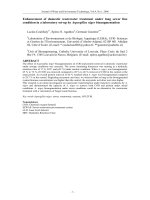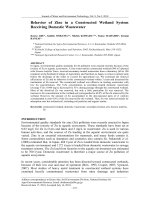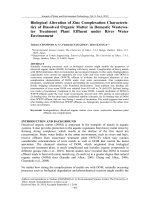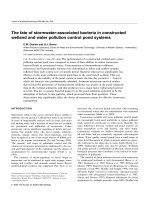Subsurface flow constructed wetland to treat domestic wastewater
Bạn đang xem bản rút gọn của tài liệu. Xem và tải ngay bản đầy đủ của tài liệu tại đây (2.88 MB, 33 trang )
Topic: Sub-surface flow constructed wetland to treat
domestic wastewater
Supervisor: Professor Nguyen Thi Loan
Group members:
Nguyen Tuan Anh
Le Nam Thanh
Content
Introduction
Study methodology
Study result
Discussion and Conclusion
I. Introduction: Constructed wetland
Wetlands: those areas that are inundated or saturated by surface or
ground water at a frequency and duration sufficient to maintain saturated
conditions.
Constructed wetland: wetland specifically constructed for the purpose of
pollution control and waste management, at a location other than
existing natural wetlands.
I. Introduction: Constructed wetland
The interest in aquatic wastewater treatment systems can be
attributed to three basic factors:
1. Recognition of the natural treatment functions of aquatic plant systems
and wetlands, particularly as nutrient sinks and buffering zones.
2. In the case of wetlands, emerging or renewed application of aesthetic,
wildlife, and other incidental environmental benefits associated with the
preservation and enhancement of wetlands.
3. Rapidly escalating costs of construction and operation associated with
conventional treatment facilities.
I. Introduction: Cost effectiveness
The major cost of implementing a discharge system is for pumping
treatment plant effluent to the site. Once there, further wastewater
treatment occurs by the application of natural processes. In some cases, the
wetland alternative can be the least cost advanced wastewater treatment
and disposal alternative. In locations where poorly drained land that is
unsuitable for land application is available, wetlands can often be
constructed inexpensively with minimal diking.
I. Introduction: Two types of CWS
I. Introduction: Sub-surface flow wetlands
The SSF type of wetland is thought to have several advantages over the
FWS type.
1.
2.
Little risk of odors, exposure, or insect vectors.
3.
Offer greater thermal protection in cold climates than the FWS type.
Greater available surface area for treatment than the FWS concept so
the treatment responses may be faster for the SF type, which
therefore can be smaller in area than a FWS system designed for the
same wastewater conditions.
I. Introduction: Horizontal sub-surface flow wetland
The design typically consisted of a rectangular bed planted with the
common reed (P. australis) and lined with an impermeable membrane.
Mechanically pre-treated wastewater is fed in at the inlet and passes slowly
through the filtration medium under the surface of the bed in a more or
less horizontal path until it reached the outlet zone where it is collected
before discharge via level control arrangement at the outlet. During the
passage of wastewater through the reed bed the wastewater makes contact
with a network of aerobic, anoxic and anaerobic zones.
I. Introduction: Horizontal sub-surface flow wetland
II. Study methodology
We collected data from scientific monographs
We based on Vietnam technical standard
We used some mathematical model
III. Study results: HSF design
The major concerns in the design of HSF constructed wetlands include:
Hydraulic and hydrological conditions
Vegetation selection
BOD5 removal mechanisms
III. Study results: HSF design
III. Study results: HSF design
Hydraulic and hydrological conditions:
Aspect ratio
Bed slope
Media types
Inlet and Outlet structures
III. Study results: Aspect ratio and bed slope
The aspect ratio (L:W) of the wetland bed is a very important
consideration in the hydraulic design of SF wetland systems, since the
maximum potential hydraulic gradient is related to the available depth of
the bed divided by the length of the flow path.
The bottom of the bed could be flat or with a very slight slope to ensure
drainage, when required. However, because of the hydraulic gradient
requirements, the aspect ratio will have to be relatively low (in the range
of 0.4:1 to 3:I ) to provide the flexibility and the reserve capacity for
future operational adjustments.
III. Study results: Media
III. Study results: Media
The recent trend in America toward the use of larger sizes of rock is
believed due to the impression created by the surface flow conditions on
many of the early systems
However, the use of smaller rock sizes has a number of advantages in
that there is more surface area available on the media for treatment, and
the smaller void spaces are more compatible with development of the
roots and rhizomes of the vegetation, and the flow conditions should be
closer to laminar. When turbulent flow occurs in the coarser media listed
in Table 5, the “effective” hydraulic conductivity will be less than the
values listed in the table.
III. Study results: Media
It is, however, necessary to provide a large safety factor against these
contingencies and adoption of an approach similar to that used in the design
of land treatment systems (30) is proposed. It is therefore recommended
that a value <1/3 of the “effective” hydraulic conductivity (ks) be used for
design. The initial design, for the same reasons, should not utilize more than
70 percent of the potential hydraulic gradient available in the proposed bed.
These two limits, combined with an adjustable outlet for the bed discharge
should ensure a more than adequate safety factor in the hydraulic design of
the system. These two limits will also have the practical effect of limiting the
aspect ratio of the bed to <3:1 for 0.6 m
III. Study results: Inlet structures
The inlet devices at operational systems include surface and subsurface
manifolds, an open trench perpendicular to the flow direction, and simple,
single point weir boxes. The manifold designs include a variety of features. In
some cases perforated pipe is used for both surface and subsurface
installations. In one case the subsurface- manifold utilized two to three
valved outlets in the cell. A surface manifold developed by TVA uses
multiple, adjustable outlet ports. This allows the operator to make
adjustments for differential settlement of the pipe and to maintain uniform
distribution of the wastewater. The proponents of subsurface inlet manifolds
claim they are necessary to avoid the build-up of algal slimes on the rock
surfaces and resulting clogging adjacent to a surface manifold.
III. Study results: Outlet structures
Outlet structures in use at operational SF wetland systems include
subsurface manifolds, and weir boxes or similar gated structures. The
perforated subsurface manifold is the most commonly used device
The use of an adjustable outlet is recommended to maintain an adequate
hydraulic gradient in the bed. This device can also have significant
operational and maintenance benefits. The surface of the bed can be
flooded to encourage, development of newly planted vegetation and to
suppress undesirable weeds, and the water level can be lowered in
anticipation of major storm events and to provide additional thermal
protection against freezing during winter operations in cold climates.
III. Study results: Vegetation selection
III. Study results: Vegetation selection
The Phragmites used in many European
systems offer several advantages for a
low maintenance treatment system.
They will grow and spread faster than
bulrush; their roots should go deeper
than cattails; and they are not a food
source for muskrats and nutria which
have been a problem for cattail and
bulrush wetlands.
III. Study results: BOD5 removal
The major oxygen source for the subsurface components (soil, gravel,
rock) is the oxygen transmitted by the vegetation to the root zone.
Organic compounds are degraded by bacteria attached to plants
underground organs (root, rhizomes) and media surface
III. Study results: HSF design
III. Study results: Information
Aspect ratio = 3:1
Media=Fine gravel (Effective size=16 mm)
Root penetration = 0.6 m
Subsurface inlet
Adjustable outlet
Normal reed (Phragmites Australis) to plant
III. Study results: Calculation
A residential area of 1000 people . Assume that 1 person consume 150 l
water/day and wastewater amount is 80% of water supply.
The amount of waste water is 120,000l/day









